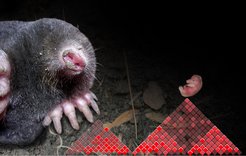Gene Regulation and Evolution
Real Lab
Our research goal is to understand how genomic changes translate into developmental phenotypes during evolution. Specifically, we study how the non-coding genome has evolved to modulate gene expression in different tissues and organisms.

We apply cutting-edge technologies to investigate gene regulation at different levels, including 3D chromosome conformation capture, single-cell technologies and epigenetic approaches. By integrating genomic data in inter-species comparative analyses, we aim to unravel shared and divergent mechanisms controlling developmental processes. We validate our findings in vivo using transgenic mice, linking changes in genome sequence and regulation with the emergence of specific traits.
Our research is focused on the biology of the mole, a species with a compendium of unique traits that makes it a fascinating model to study gene regulatory evolution. Moles live underground and have consequently evolved distinct phenotypes adapted to subterranean environments. These include eye degeneration, resistence to hypoxia or extremely adapted limbs that allow them to “swim” in soil or water. Furthermore, female moles are intersexual as they develop ovotestes instead of ovaries like most mammals. Ovotestes produce high amounts of testosterone, similar to males, which masculinize female moles and render them stronger to survive in fossorial environments. In previous research, we have generated a chromosome-resolved genome for the Iberian mole, Talpa occidentalis, thus enabling genomic and gene regulation studies in this iconic species. Using this valuable resource, we demonstrated that the development of ovotestes is associated to changes in the 3D regulatory domains of sex-specific genes (Real et al, Science 2020). Therefore, using the mole as a model, our group combines comparative genomics, 3D gene regulation and transgenic approaches to model evolution in vivo.
